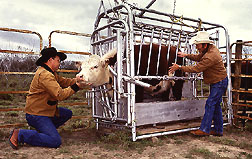Keeping Cattle Fever Ticks Away From U.S. Herds
By Alfredo Flores
August 23, 2002
It’s been nearly 60 years since the United States rid itself of cattle fever ticks that can transmit a serious livestock disease known as bovine babesiosis. But despite being eradicated in the United States, the ticks still persist in Mexican cattle, many of which cross the border for U.S. markets.
A quarantine zone in south Texas along the Mexican border is currently the only barrier to cattle fever ticks’ reentry into the United States, where all cattle are susceptible to the disease the ticks carry.
To prevent a costly reinfestation, U.S.-bound animals are “dipped” in coumaphos, an organophosphate pesticide that kills the ticks. But some Mexican ticks have developed resistance to coumaphos and other pesticides used in Mexico. So Agricultural Research Service scientists at the Knipling-Bushland U.S. Livestock Insects Research Laboratory in Kerrville, Texas, have been looking for ways to monitor resistance in Mexican ticks.
ARS physiologist Felix D. Guerrero and microbiologist John H. Pruett have identified two independent mechanisms by which ticks become resistant to pyrethroid pesticides still used in Mexico. And they have found one strain of resistant Mexican tick possessing a gene that produces a large amount of a specific esterase protein involved in the breakdown of pyrethroids.
Best of all, Guerrero and Pruett have shortened the time needed to spot pyrethroid resistance in a specimen from six weeks to just one day. Though pyrethroid resistance is becoming widespread, it's not found everywhere in Mexico, so pyrethroids can still play a role in killing ticks and preventing cattle disease.
As their research has shifted focus to coumaphos resistance, the two scientists have adapted a test that uses color to recognize resistant ticks and can be performed on crushed tick larvae or dissected adult tick brains. They are working to clone the tick genes involved in coumaphos resistance and will develop rapid tests for detecting them.
ARS is the U.S. Department of Agriculture's chief scientific research agency.
|


